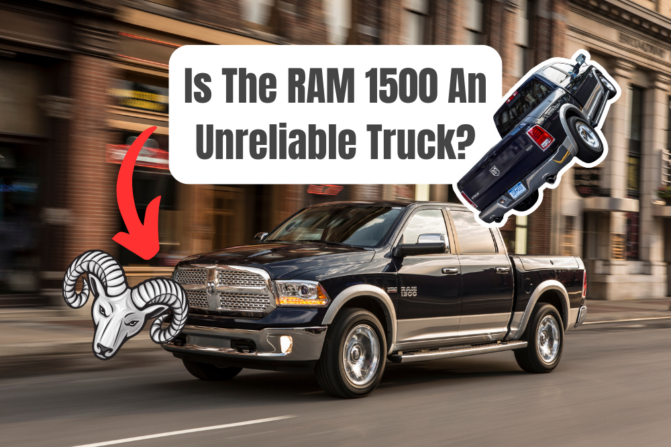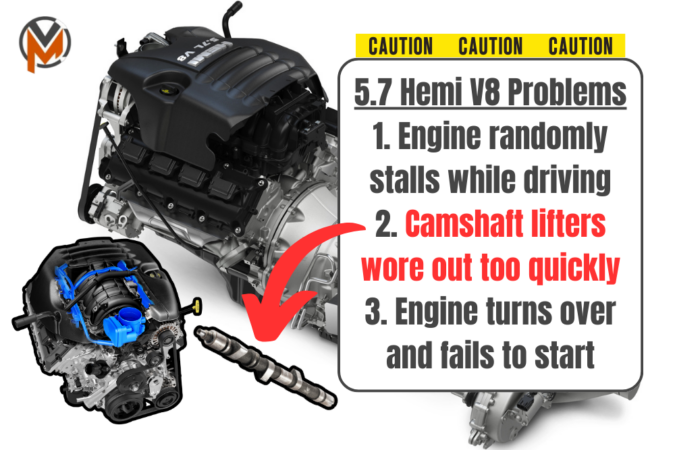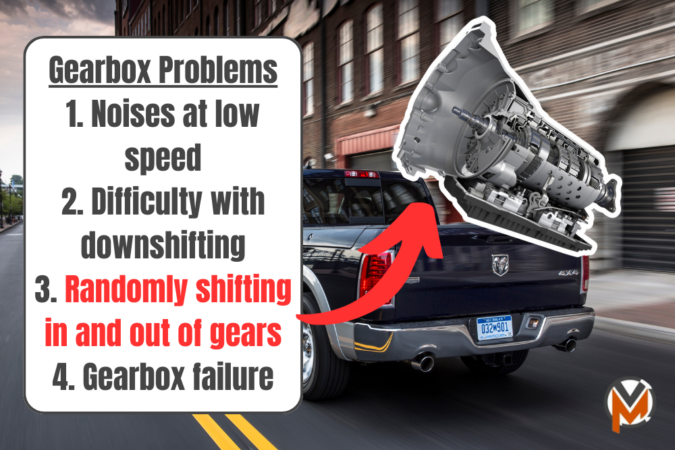The RAM 1500 is often overshadowed by its more popular rivals, the Ford F-150 and the Chevy Silverado. However, the RAM 1500 remains highly popular due to its masculine design and powerful engine options. But, there’s another crucial factor to consider before buying one… The reliability of the RAM 1500 as it changes, by model year. Is it really unreliable?
Well, there’s a good reason why there’s such a strong following for RAM 1500s these past few decades – they’re superbly reliable. This is why RAM 1500 trucks are the top choice among folks who need a dependable work truck that can run day in and day out. However, just like every other car out there, some model years and units are still prone to problems.
Best And Worst RAM 1500 Model Years
When looking at the reliability of each RAM 1500 model year, here are some of the more noteworthy and prominent model years to consider looking at. Granted, the respective reliability of the RAM 1500 model year variants mentioned below might seem damning, but these are some of the worst and most divisive model years:
2003 RAM 1500
This was a very bad year for the RAM 1500 (back then, it was still under Dodge), owing to countless reliability issues. Most of these were relatively minor issues that could be easily fixed. But, there were also pretty major problems, such as the engine. On the ’03 RAM 1500s, many owners experienced seeing the check engine light (CEL) appear frequently for no reason.
Additionally, the engine of the 2003 RAM 1500 was prone to stalling without any prior warning. There were complaints about engine knocking, too. For most owners, it’s easier to just throw the old engine away and get a new, replacement engine, instead. With that being said, the engine was just the start, as the ’03 RAM 1500 suffered mainly from interior faults.
The dashboard of the RAM 1500, in particular, had a tendency to crack pretty easily. Many owners complained about this, which is understandable. Who’d want a cracked dash in their brand-new truck? While this is mostly a cosmetic issue and won’t impact the driveability or performance of your RAM 1500, it’s still an undesirable problem. As such, it’s worth avoiding.
2010 RAM 1500
When 2010 rolled around, the RAM 1500 wasn’t spared from the litany of issues it brought to its owners. Most of these problems were related to the engine, such as it randomly turning off as you’re driving. Alternatively, the camshaft lifters wear out excessively quickly, which is really expensive to fix. And, the engine has a habit of turning over but not starting.
This isn’t helped by the huge wrath of minor problems elsewhere. Be it drivetrain, transmission, suspension, or electrical problems, the 2010 RAM 1500 gave its owners more headaches than is expected. Worse, the 5.7-liter HEMI V8, which was supposed to be built for towing heavy loads, wasn’t even that capable. Plus, it scored terrible MPGs, so it’s a lose-lose.
2012 RAM 1500
If you want to focus solely on the very worst model year of the RAM 1500, 2012 should be right up there. It was the fifth model year in the 4th-generation RAM 1500, but it somehow managed to suffer from a constant plague of issues. The bulk of it centered around its engine. Primarily, it revolved around the more powerful engine variants, like the 5.7-liter HEMI V8 engine.
These RAM 1500s had problems like ticking noises coming from behind the dash; indicating camshaft lifter failure. Fixing this on the HEMI engines was a huge undertaking, as it wasn’t just a complex repair job, but it was also expensive. Alas, this wasn’t fixed under recall. Therefore, if you’re buying a 2012 RAM 1500, make sure you check the engine first.
2013 RAM 1500
The 2013 model year of the RAM 1500 is considered by many to be among the best models out there. When it came out, it received widespread positive reception and 5-star ratings. It’s for good reason, though. You could option it with a potent HEMI engine that made 395 horsepower. Yet, the ’13 RAM 1500 remained pretty fuel-efficient, despite that.
Estimated to get 18mpg in the city and 25mpg on the highway, it’s a really good figure for a large half-ton truck. However, while the 2013 model might’ve been good as a new truck, long-term running costs are pretty expensive. This is mainly due to accelerated wear and tear and failure rates with its engine, brakes, transmission, air-conditioning, and fuel system faults.
2014 RAM 1500
The 2014 RAM 1500 marked a huge change for the line-up. It was the first generation of RAM 1500s to come with the brand’s new EcoDiesel engine. Unfortunately, as this was the first use of this engine, it came with a few teething issues. In the first model year alone (2014), 14 whole recalls were issued for the RAM 1500, most of which were to settle engine problems.
However, I’d say these engine problems weren’t all too bad, since a lot of them were fixed under recall. What is pretty bad, however, and one you’d likely have to pay out of pocket, is just how unreliable its transmission is. This included odd noises at low speeds, issues with downshifting, shifting in and out of gears while driving, or transmission failure.
2015 RAM 1500
Many of the EcoDiesel-related problems from the previous year carried through to the 2015 model year RAM 1500. Once again, the ’15 RAM 1500 was recalled countless times, where some of the underlying complaints were engine-related. However, most of the issues for this model year centered around its electrical system, fuel system, and transmission problems.
For example, the Uconnect infotainment system on the 2015 RAM 1500s was faulty and constantly malfunctioned. Even the screen had some issues, too. On top of that, the warning lights on the ’15 RAM 1500 were problematic and erratic, adding to the headaches. Since most of these issues don’t have permanent fixes, it might be worth avoiding the 2015 model year.
2016 RAM 1500
Compared to the 2014 and 2015 model years, 2016 was a bit of a reprieve for the RAM 1500. It was slightly more reliable and had less sporadic issues. However, those EcoDiesel engines had repeat problems, even by 2016. 11 recalls were issued for the ’16 RAM 1500, most of which were related to the engine. At the very least, most of these were fixed under recall.
Besides that, some of the more frequently occurring problems on the 2016 RAM 1500 mainly focused on the truck’s power locking feature. Specifically, with its rear tailgate. On some models and examples, these were faulty. Additionally, the RAM 1500 also had other issues, like broken gear shifter linkages, cruise control problems, and even defective airbags.
2017 RAM 1500
Among the more reliable model years of the 4th-gen RAM 1500, 2017 is a decent option if you’re looking to get a used example. Still, there were a few minor problems that you’d need to worry about, as well. The most notable issue was how its rear tailgate would open while the truck was in motion. Thus, ejecting whatever you’ve had stored in the truck bed.
Not only that, the transmission originally came with a fault interlock pin assembly. Moreover, the 3.0-liter diesel engine had some complaints, and recalls were made. But, overall, it is among the more reliable RAM 1500 model years. The ’17 model did come with air suspension, sports exhaust, and cool all-black exterior trim, which makes it even more appealing.




I have a 2012 Ram with that valve noise ( its more than Thic) I am 84 yrs old and retired ,because no one wants to hire me. Can you tell me how I could get that fixed as cheap as possible?
Hi Georges,
I’m sorry to hear about the valve noise issue with your 2012 Ram. To address this concern as affordably as possible, here are some steps you can consider:
Consult Multiple Mechanics: Seek opinions from several local mechanics or repair shops. Explain your situation and ask for cost estimates. Sometimes, prices can vary between providers.
Used Parts: If replacement parts are needed, consider using used or aftermarket parts, which can be more budget-friendly than brand-new ones. Just ensure they are in good condition.
DIY or Assistance: Depending on your comfort level with car repairs, you might consider tackling simpler fixes yourself if you have the tools and knowledge. Otherwise, you could ask a friend or family member for assistance.
Shop Around: Don’t hesitate to shop around for quotes and negotiate with mechanics. Some may be willing to provide discounts, especially if they understand your situation.
Online Communities: Join online forums or communities related to your vehicle make and model. You can often find valuable advice, DIY guides, and recommendations for cost-effective solutions.
Prioritize Repairs: If the valve noise isn’t affecting your vehicle’s performance or safety, you might choose to delay the repair until you can allocate more funds.
Consider Financing: Some repair shops offer financing options. While this might not make it cheaper, it can help spread out the cost over time.
Remember to prioritize safety, and if the issue could compromise your vehicle’s safety or functionality, it’s essential to address it promptly.